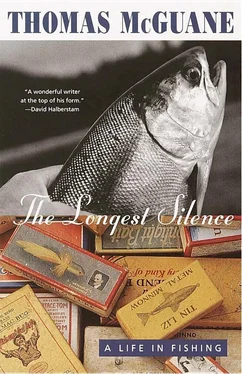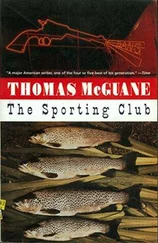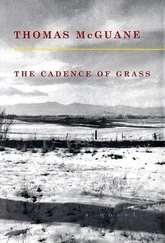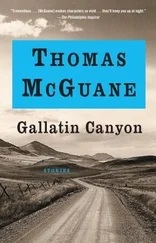The coast swam by under our plastic bubble windshield. As the sun shone in, the tension began to leave me and I fell asleep. The other anglers joined us at the hotel later that night. When I looked in on them, they were all in their underwear surrounded by Chinese prostitutes; it didn’t seem the right time for fish chat.
All winter long I received upward-revised bills from the manic depressive. But that wasn’t the true debt. For years, I ran into visitors to this beautiful river. “You were on that goddamn ship?” they’d inquire. “In that helicopter?” Ever since then I’ve been trying to treat the great river right, trying to get out of its debt. I was the guy who’d farted in church. It would be a year before I was restored to grace.
THE SHOOTING woke us up. A grizzly sow and her three large cubs had come into a camp and they were fighting over something in the yard, cuffing each other into the sides of the cabins. During the rest of the night, the guides tried without luck to send them on their way. Only sunrise sufficed, by which time the four seemed consumed by guilt from their all-night party. They slipped into the brush on the west side of camp and moments later were racing over the round stones of the river bar on their way out of Dodge.
Bears are exhilarating. They’d been around before, and in a previous year had even chewed up the proprietor’s airplane. This year, more than a few were dining on spawned-out salmon: an easy life on the verge of winter, but grizzlies did not require ease. If necessary, they would ascend the high, exposed scree slopes and snatch a mountain goat who thought he could safely watch the passing seasons in the valley below. Their rare excursions into camp certainly gave new piquancy to late-night trips to the outhouse. But this was the British Columbian wilderness, and anything that starkly contrasted with our everyday world, like the grizzly bear, the raven, the wolf or the eagle, was welcome. To the robust cubs backing around the cabins with garbage sacks and low growls, I wished to say, Have at it.
I was back on the Dean. As always with anadromous species, the question was whether or not the fish were in. These days, any delay in a run fills the angler with the fear they may not come at all. River fish that are subjected during part of their life cycle to the rapacity and lawlessness of high seas commercial fishing face a serious question of survival.
The steelhead of each river system are separate races, their characteristics derived from deep time in a particular place. Dean River fish are known for their speed and wild strength and they will come to a dry-fly better than other strains, though the depth and clarity and prevailing temperatures of the river itself have much to do with this.
I caught a small fish on the first day, then fell into a long dry spell. Casting from daybreak to sundown, wading deep in clear green water as it sweeps past the gravel bars and wooded foothills, is stirring exercise. And with a floating line, the pleasures of casting are alone fulfilling. But when the second day rolled around and I had not moved a fish, I could feel the slight clench start — the clench that suggests you might never hook another steelhead if you cast for a thousand years. Suspecting I’d sinned against the river with ship and helicopter, I sat down on the rocky abutment of an old logging bridge where tame winter wrens explored for insects in the sunny cracked stones. Half of the second blank day was over and I knew I was pressing. For some reason that’s hard to pin down, pressing won’t work on steelhead. Covering the water is all-important, but so is fishing out each cast, mending and controlling fly speed. Elements such as fly speed and the look of the fly making its small V-wake on the surface require a delicacy born of composure. An effective steelheader must control his temperament and master his touch through long hours of disappointment and the wild conditions of Northwest coastal rivers.
The boat dropped me off at the top of the most beautiful steelhead run I had ever seen. I had a quiet moment to look the water over and tie on my favorite steelhead fly, the October Caddis. There was a sparkling chute of white, boulder-strewn water at the head that quickly dissipated in the deep, flowing pool. Across from me was a high rock wall covered with lichen. A ribbon falls descended its face and made a circle of bubbles in the water below. The tailout was a shoal of small stones where the entire Dean River rushed toward the sea, accompanied by impossibly rare music.
I began casting, swept away by the radiance of this place and by the high sense of possibility this handsome water suggested to the angler. Very early on, a steelhead rose, took my fly lightly, released it and disappeared. I felt a bit sunk but went on casting in case the fish had not been touched and might move to my fly once more. Four casts later and the fish rose under the sparkling wake of the October Caddis, backed down a yard with it and vanished.
This was too much, and now almost technically hopeless, but since steelhead will come several times before they really line up on the fly, I kept casting. I tried to make the turnovers of the cast such that the fly always landed with a dead straight leader, and this turned out to be the right play because on what must have been close to my last cast, the fish instantly rose and sucked down the fly. I set the hook against a surge of power as the fish fought its way across the pool. It felt so strong that I recognized my chances of landing it weren’t particularly good. About halfway down the pool, the fish made a greyhounding jump and scared me with its size. I remember thinking it was like a picture of a jumping steelhead in some old-fashioned fishing book: parallel to the water, amazingly high against the dripping rock wall at the far side of the stream. By the time we reached the tailout, I had to make a stand. If the fish got into the rapids, it was gone. I raised the pressure until the rod was bent into the cork handle. The steelhead held in the pool for several long moments, then yielded. I felt it turn and then miraculously come my way. In a short while, I slid the fish into a small cove and tailed her, for it was a great big hen of about eighteen pounds, a beautiful slab of silver with a cloud of rose down her side. I removed the barbless hook and sent her on her way, daring to believe that I had received absolution.
I HAD AS MY GUIDE that day a young man who was perhaps retarded, and whom we shall call “Alfred.” He lived on the North Shore of the St. Lawrence River where he crabbed, lobstered, fished for cod, and assisted in the building of pretty lapped strake inshore skiffs of about twenty feet. Each December, Alfred told me, he set out for a week or two in the black spruce forest with a sled, a twelve-gauge pump shotgun and several hundred rounds of shells. He traveled in the snowy forest until the ammunition ran out and the sled was piled high with grouse, which he trailed home for his mother to cook and can for the winter. His companion was a small Indian dog of a kind that fascinated me, as they were distributed mostly among the Montaignais who bred them carefully and held on to them against all odds, including the offer of significant monies. These dogs were small and mean, particolored, and loyal only to their owners. Anyone else who came near them, they bit. The Indians believed if they weren’t mean, they weren’t any good. They were too small to do much harm: in fact, as will be seen, they did much good.
The North Shore grouse woods are so densely forested that to blunder around in them hunting grouse is futile. So the hunter who has surmounted the terrific difficulty required in obtaining an Indian dog walks the old loggers’ traces while the dog, well out of sight in the forest, hunts. Upon finding a grouse, the little dog flushes him up a tree, then sits at its base barking until the hunter finds him and shoots the bird. On they go, for long days. They are subsistence hunters. The fates of dog and hunter are intertwined, and there is something terrific about the way they work together in order to survive. The little dog never lets the Indian out of his sight and the Indian, though impoverished, will not sell the dog to anyone.
Читать дальше












